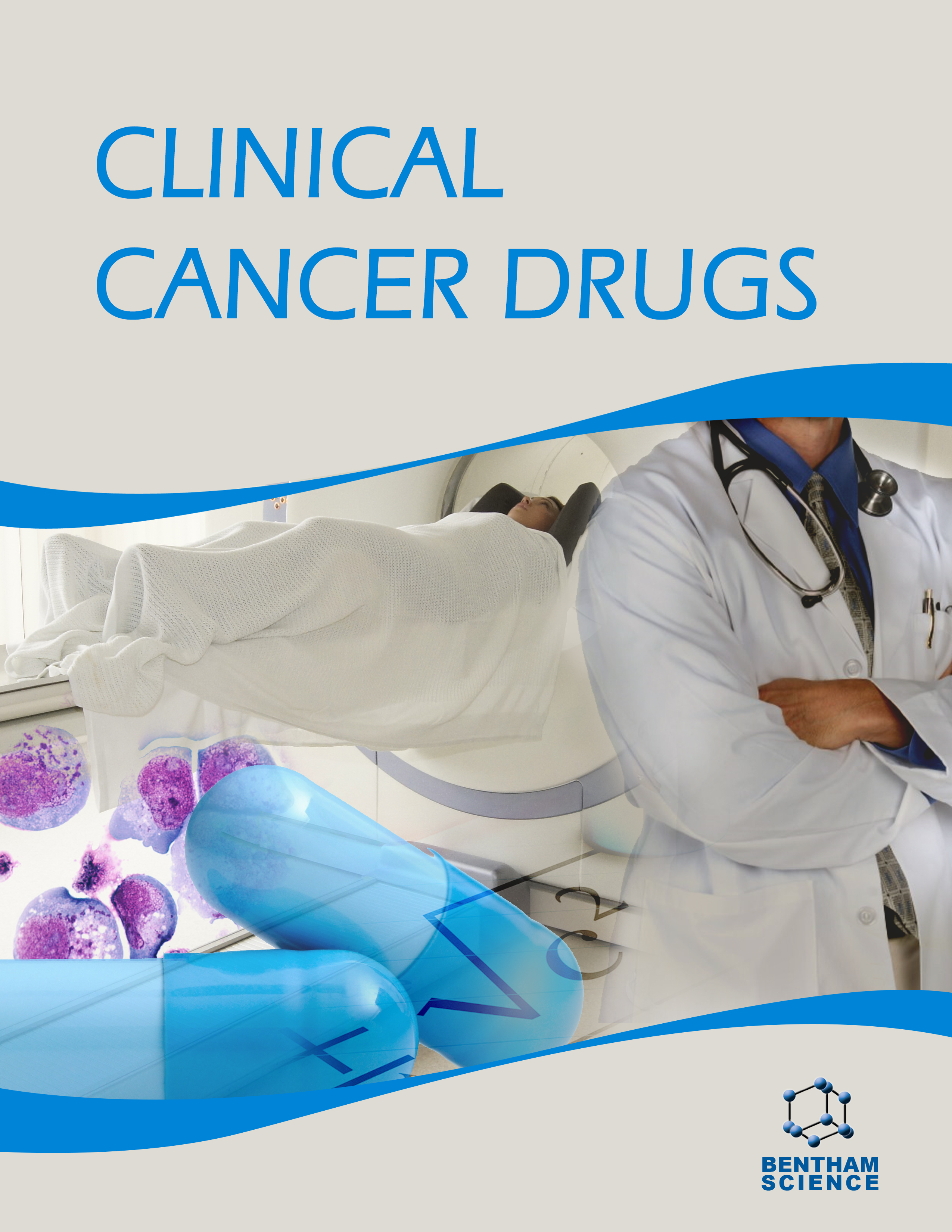- Home
- A-Z Publications
- Clinical Cancer Drugs
- Previous Issues
- Volume 3, Issue 2, 2016
Clinical Cancer Drugs - Volume 3, Issue 2, 2016
Volume 3, Issue 2, 2016
-
-
Novel Antibody Therapeutics Targeting Mesothelin In Solid Tumors
More LessAuthors: Xiao-Yan Zhao, Babu Subramanyam, Nenad Sarapa, Sven Golfier and Harald DinterBackground: Monoclonal antibodies have become attractive clinical anticancer drugs in the last 3 decades due to their targeting specificity and suitable pharmacokinetic properties. Mesothelin is a tumor-associated antigen with limited expression in normal tissues. It is frequently over-expressed on the cell membrane of a number of epithelial malignancies (e.g. mesothelioma, pancreatic, ovarian, lung, triple negative br Read More
-
-
-
Efficacy of Therapy with c-Met/HGF Inhibitors in Solid Tumors: A Systematic Review Based on 24 Clinical Trials
More LessAuthors: Yin Yin, He Wang, Mingjie Lu and Wei ZhuBackground: The Mesenchymal Epithelial Transition factor (c -Met, MET) is the tyrosine kinase cell surface receptor, and the only known high affinity ligand is hepatocyte growth factor (HGF). HGF/MET pathway is required for not only normal physiologic development, but also a wide variety of human malignancies. More and more pieces of evidence have been identified for the treatment of a variety of malignancies with c-Met/ Read More
-
-
-
Efficacy of Bacteria in Cancer Immunotherapy: Special Emphasis on the Potential of Mycobacterial Species
More LessAuthors: Santosh Podder, Srabanti Rakshit, Manikandan Ponnusamy and Dipankar NandiBackground: Conventional cancer therapies such as chemotherapy and radiotherapy are often characterised by lack of tumor specificity, increased resistance of tumors to drugs, failure to detect metastases and undesirable side effects. Several years back, William Coley’s pioneering work on the use of bacteria opened up the new field of cancer immunotherapy. The search for alternative and better strategies in cancer treatment Read More
-
-
-
Ameliorated Chemotherapeutic Potential of Diverse Dose Flouropyrimidine Therapy By Etodolac via NF-ΚB Pathway, PPAR-γ Expression and COX-II Inhibition in DMH Induced Colon Cancer Rats
More LessAuthors: Honey Goel, Kulbhushan Tikoo, Pinakin Arun Karpe, Richu Singla and Vivek Ranjan SinhaBackground: 5-Flurorouracil (5-FU) chemotherapy has been one of the extensively employed standard therapies for the treatment of colon cancer. Various molecular interventions and dose modulations in the form of adjuvant therapies has been exploited for better therapeutic efficacy and low adverse effects to improve overall survival rate in advanced colorectal cancer. Non-steroidal anti-inflammatory drugs (NSAIDs) have sho Read More
-
-
-
Evaluation of Antitumor Potential of Forskolin and Andrographolide Employing Potato Tumor Bioassay Model
More LessAuthors: Velpula Suresh, D. Raju, Rupula Karuna, Godugu Deepika and Sashidhar R. BBackground: Forskolin and Andrographolide are extensively used in many parts of Asia as traditional herbal medicines. Potato tumor bioassay has several advantages for pre-screening of antitumor molecules as compared to animal cell based bioassays. The present study was aimed to evaluate the antitumor potential, biochemical changes induced by the test compounds, and screening of their ability to interact with DN Read More
-
-
-
Transforming Mutations of Jak3 (A573V and M511I) Show Differential Sensitivity to Selective Jak3 Inhibitors
More LessAuthors: G. Steven Martinez, Jeremy A. Ross and Robert A. KirkenBackground: A medical need exists for successfully treating patients afflicted with leukemia and especially those that relapse and ultimately become refractory to front line chemotherapies. Leukemia cases are particularly high within Hispanic populations where this disease is among the most frequently occurring cancer. A possible cause is somatic mutations in Janus tyrosine kinase (Jak3). Fourteen somatic mutations hav Read More
-
-
-
Tumor-selective Cytotoxicity of a Novel Pentadiene Analogue on Human Leukemia/lymphoma Cells
More LessBackground: A novel series of structurally divergent 1,5-diaryl-3-oxo- 1,4-pentadiene analogues 1-10 displayed marked cytotoxic potencies towards a number of human leukemia/lymphoma cells. Objective: To identify novel selective cytotoxic compounds that induce apoptosis. Methods: The Differential Nuclear Staining (DNS) screening protocol was utilized to measure the cytotoxicity of all experimental dienones on several c Read More
-
Most Read This Month
Article
content/journals/ccand
Journal
10
5
false
en


